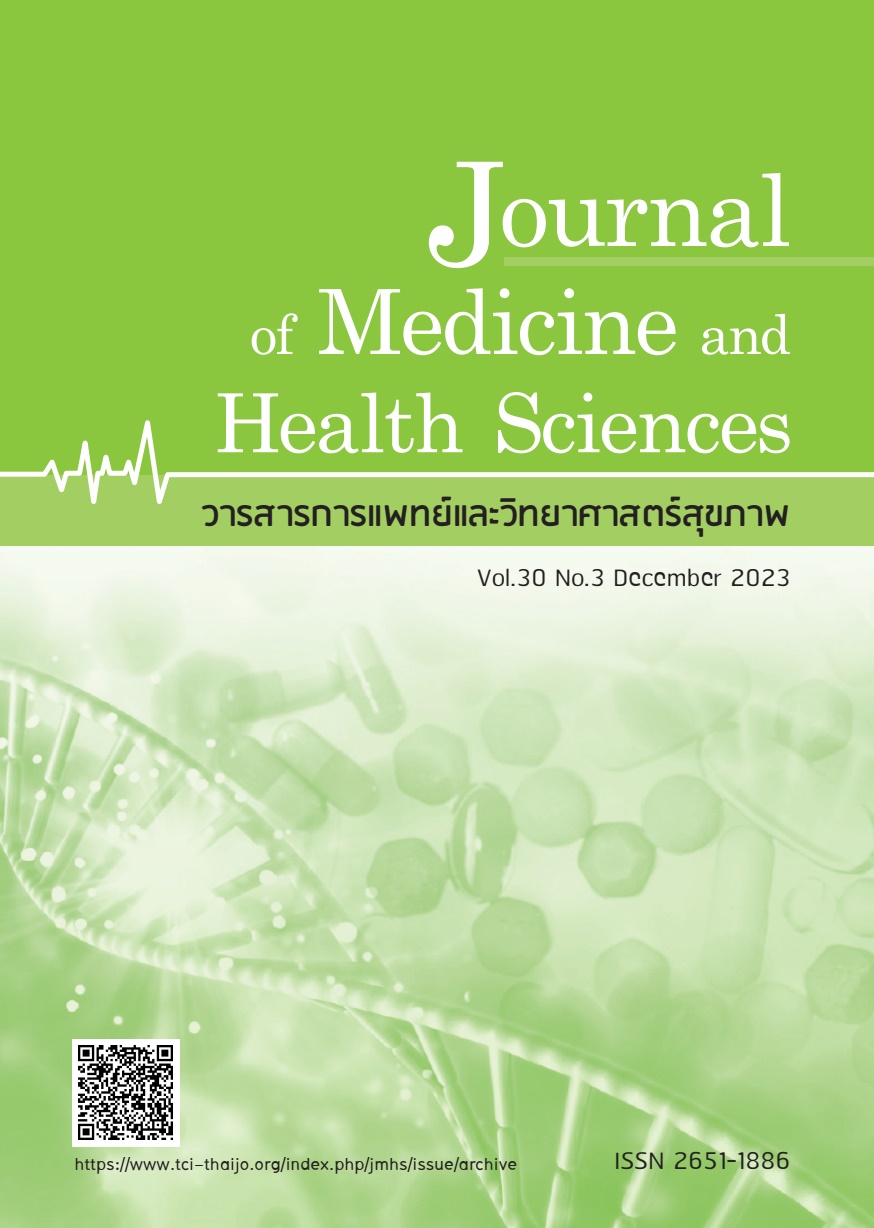ความแม่นยำในการวินิจฉัยการตัดชิ้นเนื้อแบบแช่แข็งระหว่างการผ่าตัดของต่อมน้ำเหลืองเซนติเนลบริเวณรักแร้ในผู้ป่วยมะเร็งเต้านมที่ศูนย์การแพทย์สมเด็จพระเทพรัตนราชสุดาฯ สยามบรมราชกุมารี
คำสำคัญ:
มะเร็งเต้านม, ต่อมน้ำเหลืองเซนติเนล, การวินิจฉัยการตัดชิ้นเนื้อแบบแช่แข็ง, ความแม่นยำบทคัดย่อ
การวินิจฉัยการตัดชิ้นเนื้อแบบแช่แข็ง (frozen section) จากต่อมน้ำเหลืองเซนติเนลบริเวณรักแร้นั้นมีประโยชน์ในด้านการป้องกันการผ่าตัดเลาะต่อมน้ำเหลืองบริเวณรักแร้ออกโดยไม่จำเป็นในผู้ป่วยมะเร็งเต้านมระยะเริ่มต้น ซึ่งจะสามารถป้องกันการเกิดผลเสีย อันได้แก่ แขนและหัวไหล่ติด แขนบวม ติดเชื้อและชา โดยการศึกษาย้อนหลังนี้ได้ทำการศึกษาในผู้ป่วยมะเร็งเต้านมที่ได้รับการวินิจฉัยจากการตัดชิ้นเนื้อแบบแช่แข็งจากต่อมน้ำเหลืองเซนติเนลบริเวณรักแร้ ในศูนย์การแพทย์สมเด็จพระเทพรัตนราชสุดา ฯ สยามบรมราชกุมารี คณะแพทยศาสตร์ มหาวิทยาลัยศรีนครินทรวิโรฒ ระหว่างช่วง มกราคม พ.ศ. 2552 ถึง สิงหาคม พ.ศ. 2565 จำนวน 186 ราย เพื่อนำมาเปรียบเทียบกับการวินิจฉัยด้วยพาราฟิน แล้วนำมาคำนวณ ค่าความไว ค่าความจำเพาะ ค่าความแม่นยำ ค่าทำนายเมื่อผลบวก และค่าทำนายเมื่อผลลบของการวินิจฉัยการตัดชิ้นเนื้อแบบแช่แข็ง ผลการศึกษาพบว่า มีผู้ป่วยจำนวน 55 ราย (ร้อยละ 29.57) มีการลุกลามไปยังต่อมน้ำเหลืองบริเวณรักแร้ 8 ราย ตรวจเป็นลบจากต่อมน้ำเหลืองเซนติเนล ขณะที่การวินิจฉัยด้วยพาราฟินให้ผลบวก (ผลลบลวง) การศึกษานี้มีค่าความไวร้อยละ 85.45 ค่าความจำเพาะร้อยละ 100 ค่าความแม่นยำร้อยละ 95.70 ค่าทำนายเมื่อผลบวกร้อยละ 100 และค่าทำนายเมื่อผลลบร้อยละ 90.90 ตามลำดับ นอกจากนี้ ยังพบว่าขนาดของก้อนที่เต้านมในส่วนที่มีการลุกลาม มีผลต่อการลุกลามไปยังต่อมน้ำเหลืองอย่างมีนัยสำคัญทางสถิติ โดยสรุป การตัดชิ้นเนื้อแบบแช่แข็งของสถาบันทางการแพทย์ของเรานี้มีความน่าเชื่อถือและแม่นยำต่อการวินิจฉัย ซึ่งมีผลความแม่นยำใกล้เคียงกับการศึกษาอื่นๆ
References
Global Cancer Observatory Cancer Today. International Agency for Research on Cancer: Lyon, France.
Breast Tumours, WHO Classification of Tumours, 5th Edition, ed. WHO Classification Editorial Board, 2019.
Abass MO, Gismalla MDA, Alsheikh AA, et el. Axillary lymph node dissection for breast cancer: Efficacy and complication in developing countries. J Glob Oncol 2018;4:1-8.
Dooijeweert C, Diest PJ, Ellis IO. Grading of invasive breast carcinoma: The way forward. Virchows Archiv 2022;480:33-43.
Nascimento RGd. Histological and molecular classification of breast cancer: what do we know? Mastology 2020;30:1-8.
Malhotra GK, Zhao X, Band H, et al. Histological, molecular and functional subtypes of breast cancers. Cancer Biol Ther 2010;10:955-60.
Makki J. Diversity of breast carcinoma: Histological subtypes and clinical relevance. Clin Med Insights Pathol 2015;8:23-31.
Farrokh A, Goldmann G, Meyer-Johann U, et al. Clinical differences between invasive lobular breast cancer and invasive carcinoma of no special type in the German Mammography-screening-program. Women Health 2022;62:144-56.
Djurisic I, Santrac N, Buta M, et al. Can we use frozen section analysis of sentinel lymph nodes mapped with methylene blue dye for decision making upon onetime axillary dissection in breast carcinoma surgery in developing countries? J BUON 2015;20:492-7.
Alberto MM, Fadi W. Abdul-Karim, et al. Intraoperative Consultation. Elsevier Saunders, Philadelphia, 2015.
Jerome BT, Aliya NH, Anthony GM. Biopsy interpretation: The frozen section, 2nd edition. Lippincott Williams & Wilkins, a Wolters Kluwer business, Philadelphia, 2014.
Himakhun W. Intraoperative consultation of sentinel lymph node for mammary carcinoma. TMJ 2013;13:262-9.
Elhaj A, Elshaikh AA. National guidelines for management of breast cancer: For enforcement or persuasion. Sudan Med J 2012;3:213-8.
Namdar ZM, Omidifar N, Arasteh P, et al. How accurate is frozen section pathology compared to permanent pathology in detecting involved margins and lymph nodes in breast cancer? World J Surg Oncol 2021;19:261.
Moghimi M, Ghoddosi I, Rahimabadi AE, et al. Accuracy of sentinel node biopsy in breast cancer patients with A high prevalence of axillary metastases. Scand J Surg 2009;989:30-3.
Vohra LM, Memon AA, Khaliq T, at al. Sentinel lymph node biopsy in breast cancer by using isosulfan blue. Pak J Med Sci 2009;25:786-90.
Lu Q, Tan EY, Ho B, et al. Achieving breast cancer surgery in a single setting with intraoperative frozen section analysis of the sentinel lymph node. Clin Breast Cancer 2013 Apr;13:140-5.
Sheshe A, Muhammad A, El-Yakub A, et al. Comparing frozen and paraffin section in the detection of metastases in sentinel lymph node in breast cancer in Aminu Kano teaching hospital, Kano, North-Western, Nigeria. Sub-Saharan Afr J Med 2018;5:74-9.
Lai SK, Masir N, Md Pauzi SH. Intraoperative frozen section sentinel lymph node assessment in breast cancer: A tertiary institution experience. Malays J Pathol 2018;40:121-8.
Panawattanakul R. False negative rate of sentinel lymph node biopsy in patient with early breast cancer in Udonthani hospital. Udhhosmj 2018;26:1-8.
Hashmi AA, Riaz R, Zia S, et al. Impact of Histological Type and grade on the diagnostic accuracy of intraoperative frozen section for detecting breast cancer metastasis to axillary sentinel lymph nodes. Cureus 2021;13:16146.
Lai SK, Masir N, Md Pauzi SH. Intraoperative frozen section sentinel lymph node assessment in breast cancer: A tertiary institution experience. Malays J Pathol 2018;40:121-8.
Elshanbary AA, Awad AA, Abdelsalam A, et al. The diagnostic accuracy of intraoperative frozen section biopsy for diagnosis of sentinel lymph node metastasis in breast cancer patients: a meta-analysis. Environ Sci Pollut Res 2022;29:47931-41.
Loh Z-J, Lee K-T, Chen Y-P, et al. Falsenegative frozen section of sentinel nodes in early breast cancer (cT1-2N0) patients. World J Surg Oncol 2021;19:183.
Liang C, Li L, Zhu M, et al. The guiding significance of the number of positive sentinel lymph nodes in frozen section for intraoperative axillary dissection in early breast cancer. Cancer Manag Res 2021;13:4803-10.
Nimboriboonporn A, Sa-nguanraksa D, Samarnthai N, et al. Predictive factors for sentinel lymph node metastasis and validation of memorial Sloan–Kettering cancer center nomogram in Thai breast cancer patients: Predictive factors for sentinel node metastasis. Thai J Surg 2020;41:29-39. [in Thai]
Leidenius MH, Vironen JH, Heikkilä PS, et al. Influence of isolated tumor cells in sentinel nodes on outcome in small, node-negative (pT1N0M0) breast cancer. Ann Surg Oncol 2010;17:254-62.
Galimberti V, Cole BF, Zurrida S, et al. Axillary dissection versus no axillary dissection in patients with sentinel- node micrometastases (IBCSG 23-01): A phase 3 randomised controlled trial. Lancet Oncol 2013;14:297-305.
Downloads
เผยแพร่แล้ว
How to Cite
ฉบับ
บท
License

This work is licensed under a Creative Commons Attribution-NonCommercial-NoDerivatives 4.0 International License.





